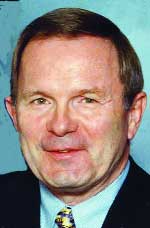Find the structure to fuel revenue growth

Whether a company's structure is organizedaround sectors, business units, divisions or groups,most government contractors find that the independentfederation model is an effective structure forbusiness development ? to a point.
Whether a company's structure is organizedaround sectors, business units, divisions or groups,most government contractors find that the independentfederation model is an effective structure forbusiness development ? to a point.A business unit is usuallybuilt with strongdivisional leadership.This model allows forrecruitment of employees,resources and continuedwork on contracts,while facilitatingsome degree of organicgrowth.But at some point, organic growth willbegin to stagnate as add-on work, new contractsand new opportunities slow down ordry up. The only perceived avenue to ensuresubstantive growth is to make an acquisitionor partner with another organization tobolster the numbers.What has developed is an independentfederation, an autonomous businessunit. This type of silo is usually personality-and program-driven, combiningstrong leadership with theincentive to drive short-term numbers.On the surface, things look fine.What is harder to recognize and whateventually grows to be a significantchallenge is the evolution of multiple independentfederations competing for businessand internal resources. From a managementstandpoint, it is nearly impossible to leadand coordinate a strategic and cohesivebusiness development effort under theseconditions.There are several signs that the end isnear for the effectiveness of this structure: In the end, with the independent federationstructure, strategic growth becomes asignificant challenge. A common remedy isto consider an acquisition. But the alternativeapproach is to build a business developmentmind-set or process and disciplinethat will allow organic growth across businessunits.This can be accomplished by establishinga corporate strategic business unitcharged with growing a strategic pipeline,thus positioning the organization as aleader in the industry with the appropriateservices, client base and business developmentcapability.If things are going reasonably well, yournumbers are good, and you're aware of youropportunities and challenges, then, in thevernacular, "don't fixwhat ain't broke."However, if revenuegrowth is slowing orstagnant and, as a consequence,you've consideredmaking changes,we will share some keyconsiderations in our next column to facilitatethe transition from an independent federationbusiness development model to astrategic-growth business developmentmodel.

Bill Scheessele (bill.scheessele@mbdi.com) is
chairman and chief executive officer at MBDi, an
international business development professional
services firm.

- 1. You uncover the existence of disparate
processes for capturing business. When
opportunities appear, you have difficulty
coordinating any capture process that
involves more than one sector or business
unit.
2. You find that your independent federations
tend to hoard resources. Separate
business development teams report
directly to the head of one business unit
and focus their efforts only on that business
unit.
3. An individual representing the services
of one division is seldom able to understand
and use the capabilities of another
division.
4. Systems and processes built internally
around an independent federation unit
result in a disproportionate number of
capture management, business development
and project management processes.
This proliferation of processes eventually
affects revenue.
5. It's more difficult to take the lead on
prime contracts, control partnering with
other organizations or position the company
as either a prime or a sub.
Independent business units compete
internally and externally.
6. There is a lack of shared business intelligence.
Information gleaned about opportunities
and people stays embedded in
individual business units. There is no
central repository of critical business
development information or intelligence
data. There is little willingness to share.
Bill Scheessele (bill.scheessele@mbdi.com) is
chairman and chief executive officer at MBDi, an
international business development professional
services firm.
NEXT STORY: Market disruption presents silver lining

